What is Papua New Guinea Like?
The last (almost) two weeks in Papua New Guinea have been an incredible eye opener into a country I knew next to nothing about. Papua New Guinea, or PNG as most people refer to it over there, is one of the last relatively untouched and mysterious places in the world.
I was invited by the Papua New Guinea Tourism Promotion Authority to visit and see what life was like over there – and what I found was a very different world to what I’m used to, and one I think is totally underrated among British tourists.
What is Papua New Guinea Like?
Who’s been to Papua New Guinea?
Now I know a lot of people who travel for a living, and yet only two people who’ve been to Papua New Guinea. Just that fact made the country all the more intriguing to me – I wanted to know more.
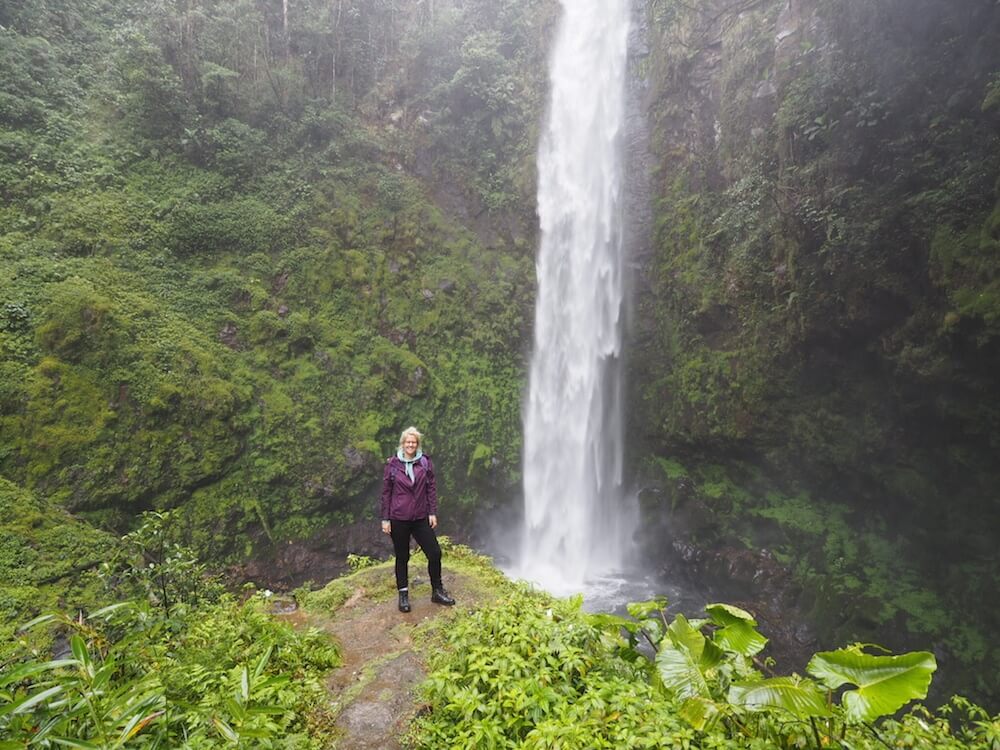
– Conquering a waterfall walk in Tari, nothing to be scared of
Before I went I was nervous – I had no idea what Papua New Guinea was going to be like. I Googled of course, and old damaging stories online seemed to override any positives. When I announced I was going on my Facebook page I had many messages from travel friends telling me to ‘be careful’ – they never normally do that when I go off on my adventures.
As soon as I arrived into the airport at Port Moresby, Papua New Guinea’s capital, I knew I’d be alright. The staff there had big smiles for 5am and I had more than a few people excitedly asking where I was going next.
I caught my onward flight to Mount Hagen, up in the Highlands, and was picked up from the airport by a guy with a huge betel nut grin. This ‘betel nut’ has a lot to answer for in PNG – chewers are left with black teeth and what looks like a bloody mouth, although none of them seem to care. I promised myself I’d try it when I was there but I just couldn’t bring myself to do it to my little pearly whites.
Watch my YouTube video to see what to expect from PNG!
Check out my channel at VickyFlipFlop
Up in the Highlands
For my first week I was up in Mount Hagen and Tari in the Highlands, and to be honest, my overriding memory was that of feeling overwhelmed by how the people here lived. I don’t want to patronise, say my way is better, or pity others, but as we drove around and saw the houses, the clothes and people sitting around trying to sell what they could – usually pigs or coffee beans – it shook me how different it was to England, and even to most of the places I’ve travelled to before.
Talking materialistically, the people I saw on the roads, and met in the villages, had very little but what was on them.
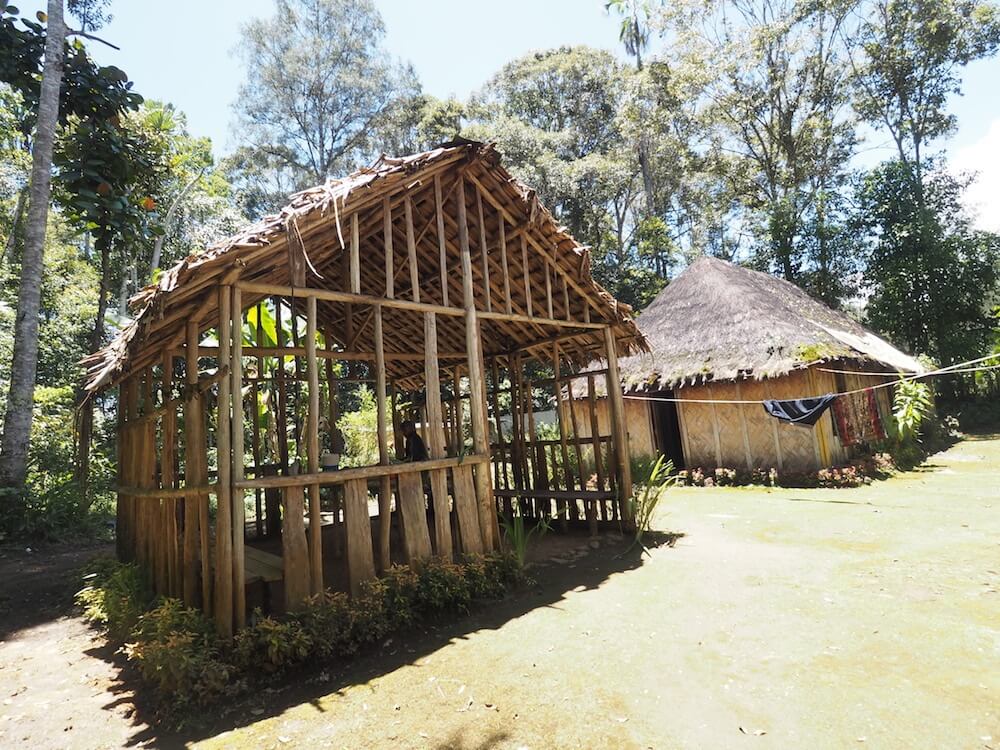
– Our lunch time stop, and Joel’s house
Many people walked the roads barefoot – I asked my guide why and he just replied “they were used to it” – some holding machetes, just for work, but which was very unnerving as they stared into the bus, especially with the aforementioned betel nut smiles.
In Tari I made friends with a little boy, Joel. Well, he told me he was 17 but looked more 12, and he wanted to show me round his house (above, in the background). He proudly showed me how the doors to his tiny room opened both ways. He had an old mattress on the floor, his school work on the walls as decoration… and very little else. He and his four brothers lived with his dad and grandfather, as his mum had died. They had a room each, with the intersecting walls made from weaved wood, and then there was a burning log in the middle to give warmth, although it seemed like it was just smoking them out.
When I left I thanked him for showing me round and he shook my hand and said he really liked the name Vicky.
READ MORE: Where to Stay in Papua New Guinea
The cultural shows
I visited six different villages in the Highlands, each with their own traditional shows. I had someone ask me on Instagram Stories whether they were just for the tourists, or if they did actually dress up like that.
Good question.

– Me with the Skeleton Boys of Mount Hagen
The cultural shows in Papua New Guinea have traditionally been performed for special occasions, and for VIPS. And now, the tourists are the VIPs. The shows are still performed at celebrations, and they’re an important part of their culture that they want to ensure carries on. I didn’t feel they were mega touristy and just for us, but a fascinating rendition of how they still perform within the tribes.
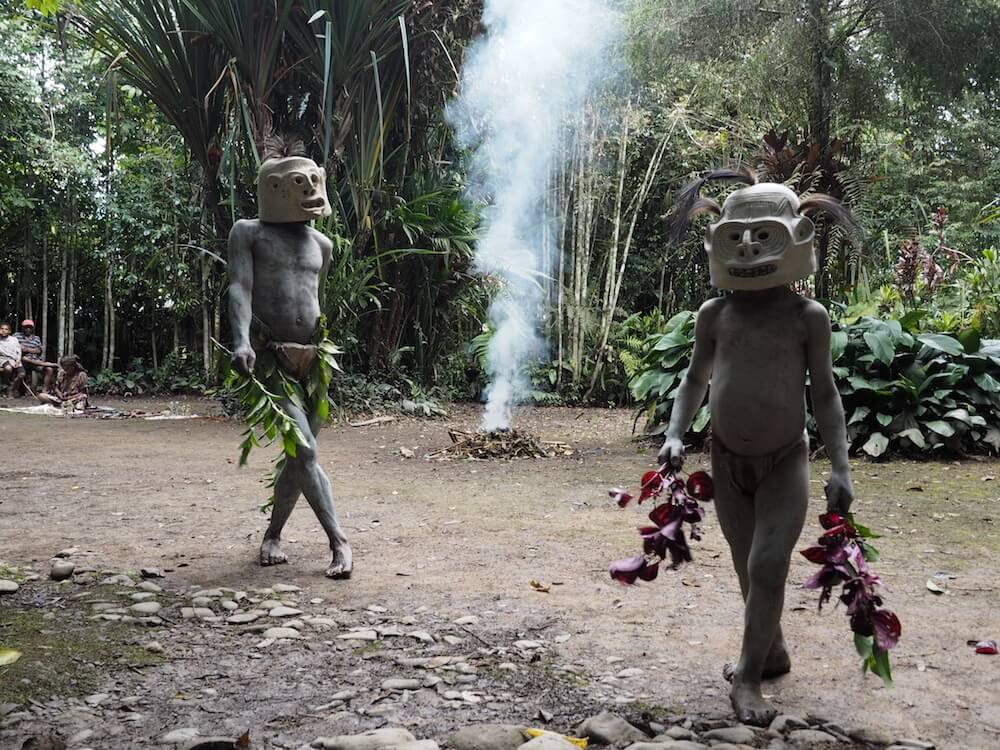
– The Mud Men of Mount Hagen
With all the face and body paint, feathers, wigs and decoration, the Highlands cultural shows gave a real insight into life and the traditions here, and what Papua New Guinea is like in reality. The performers danced, sang and shared their culture through performance.
I’ll be writing a whole blog post about the cultural shows – got lots of photos and videos I want to share and they were a definite highlight!
The Highland natives
The locals I met here were super friendly. I mentioned this to Thomas, my guide from Ambua Lodge, as we were trekking down to a waterfall, and he said how tourists are the only people to bring money into a village up in the Highlands. They have no other way of making money, insinuating that of course they’d be friendly, but, what that meant to me was that they actually wanted tourists up here.
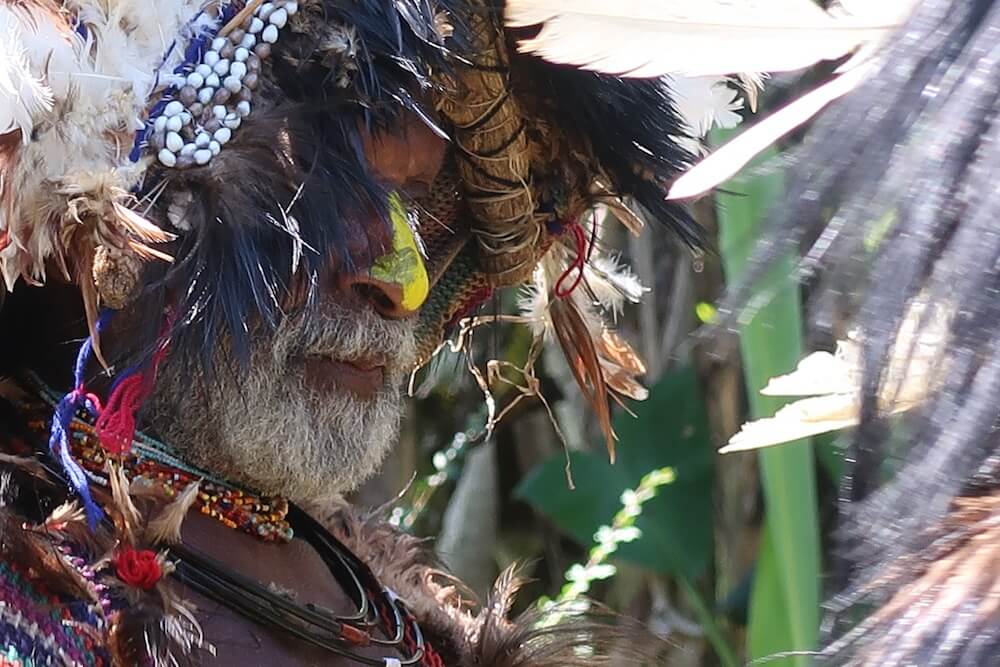
As we drove past, our bus of three Westerners, both the children and adults on the roads would wave. Some stood gawping at us on the bus, and I guess in turn, we gawped back.
I definitely didn’t feel any negative or aggressive vibes towards me as we travelled around the Highlands.
Driving around PNG
I spent around 15 hours in buses and off roaders driving round different parts of Papua New Guinea. As the Land Rovers came blazing on through the puddles and pot holes, I bounced around in our old bus while the driver tried to swerve the obstacles.
You definitely don’t drive round Papua New Guinea for the smooth ride.
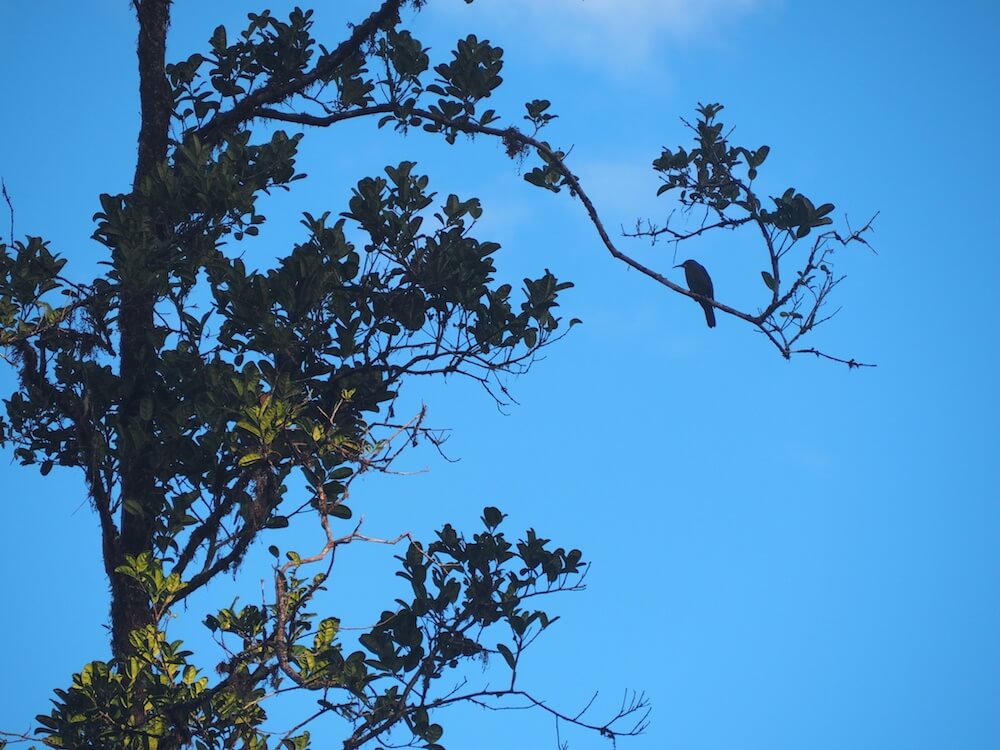
To sum up the roadside scenery of the Highlands briefly, you can expect lush forests, looming mountains, people walking on the side of the road often carrying babies, or holding hands, children stood staring with trails of snot from their noses, litter mounting up in the busiest areas, mobile phone company signs everywhere, locals carrying anything from school work to babies in their traditional bilum bags (crocheted string bags popular here) often carried on the forehead, the occasional skeleton of a car decorating the road side, markets, dart boards for entertainment, and occasionally people washing in the river, both their clothes and themselves.
We drove past ceremonial grounds, past graves (above ground, out of respect in their beliefs), court houses and banks, which the drivers would point out to me, sounding proud as I nodded.
“We don’t use farm animals to plough the ground here though”
“Oh really, why not?” Thinking it would be religious…
“Can’t afford them,” that shut me up.
I looked out to the women in the field hoeing the ground, wearing only grass skirts, as is the tradition, and vowed never to complain about hard work ever again.
Flying around PNG
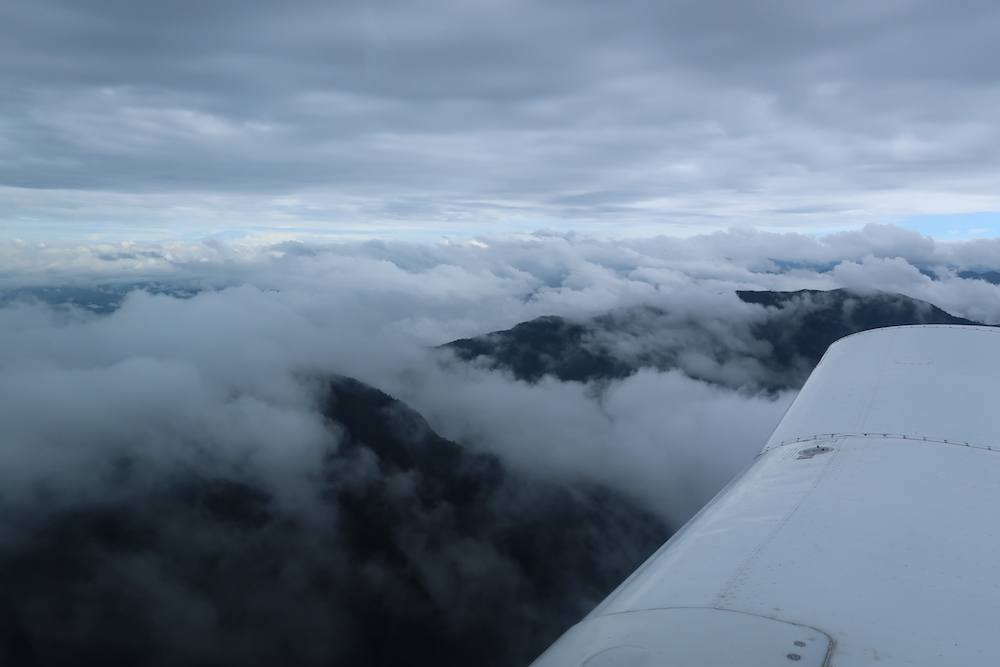
One of the highlights of my experience in Papua New Guinea was taking an 8-seater charter plane over the mountains between Mount Hagen and Tari. Flying where the mountains met the clouds was awesome – and it was a great way to experience just how vast and undeveloped the country is.
From my birds eye view I could see how sparse the villages were, and the smoke signals that I was told tribes still use to contact each other over long distances. Although, phones are just becoming more popular and affordable in PNG – it was strange to thing of a dressed up Huli wigman checking his texts.
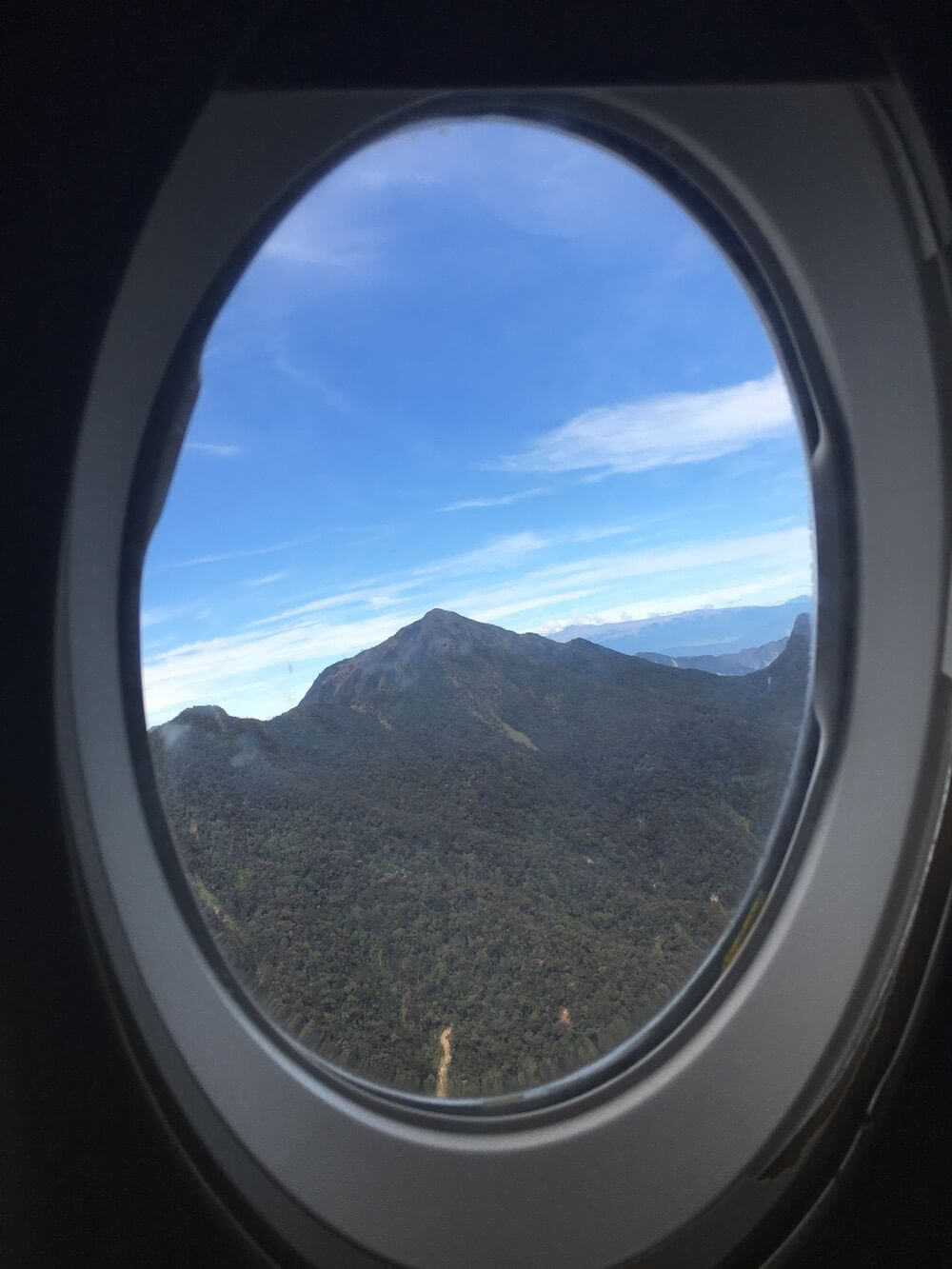
All the land in Papua New Guinea belongs to the natives, to the tribes, and for anyone to build they require the approval of the village’s elders. Kind of like a local council. With limited funds and vision, the landscape hasn’t changed much – you won’t find high rise development here.
The small areas that have been developed have generally been sold off to ex pat investors who’ve promised to redevelop and provide jobs and income. This was the case with the three incredible places I stayed – Rondon Ridge, Ambua Lodge and the Walindi Plantation Resort.
These luxurious lodges I stayed at were in stark contrast to the housing we drove past to get to them.
Pigs in Papua New Guinea
Pigs are a valid currency in Papua New Guinea, and an essential part of the culture. As we drove past a pig sale – picture lots of dead pigs tied to poles with prices attached – my guide said it was to raise quick money for their children’s upcoming school fees.
He said you had to pay for education in this part of PNG, and villagers would group together to pay for the children.
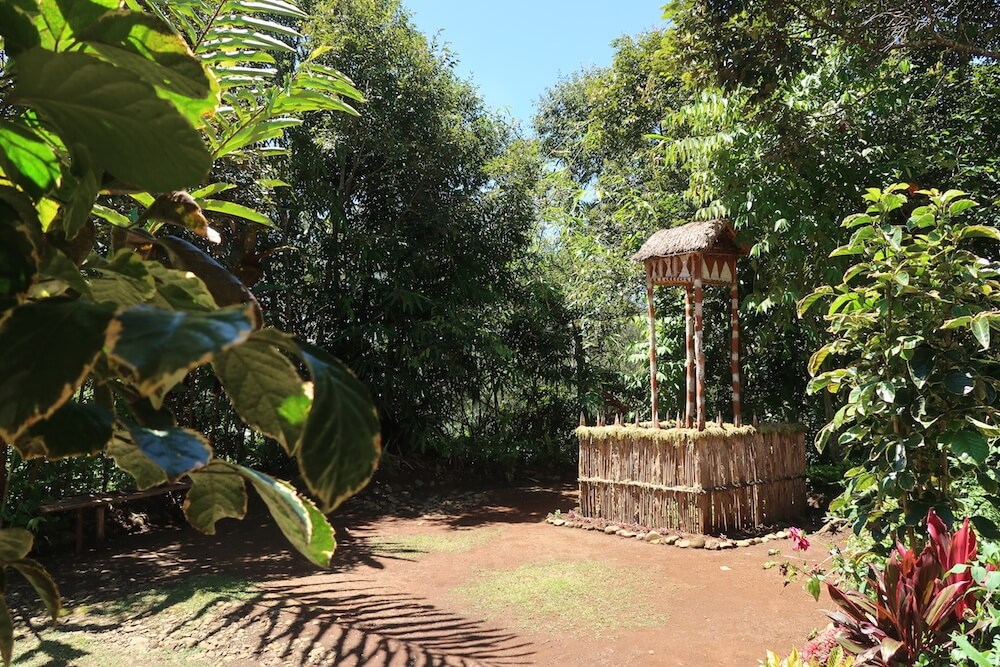
– A replica of a traditional grave, although they’re not allowed to ‘bury’ them like this anymore
I’ve never seen so many pigs as I did in Papua New Guinea. They scuttled out in front of us on the dilapidated roads, they’d trough at the wayside, or snuffle in the gutters. That is, apart from that one particular pig I saw, that was covered in banana leaves and looked to be cooked up for the next tribe’s dinner.
Any ceremony – weddings, period celebrations, funerals – was an excuse to either give pigs, accept pigs as gifts, or to eat pigs.
Visiting New Britain
After the Highlands I went to Kimbe Bay, near Hoskins on New Britain island. This felt like a totally different Papua New Guinea and any assumptions I’d had before about ‘what life was like in Papua New Guinea’ made me realise I was basing my whole impression of the country on just a relatively small area.
The slogan for Papua New Guinea tourism is ‘A Million Different Journeys’ and I can totally see where they’re coming from – it’s hard to sum up any feelings or thoughts about what Papua New Guinea is like when you have so much diversity in people, beliefs, topography, and ways of life. But that’s what I’m attempting to do.
In New Britain palm oil is one of the main industries and there were thousands, and thousands, of palm trees lining the road.
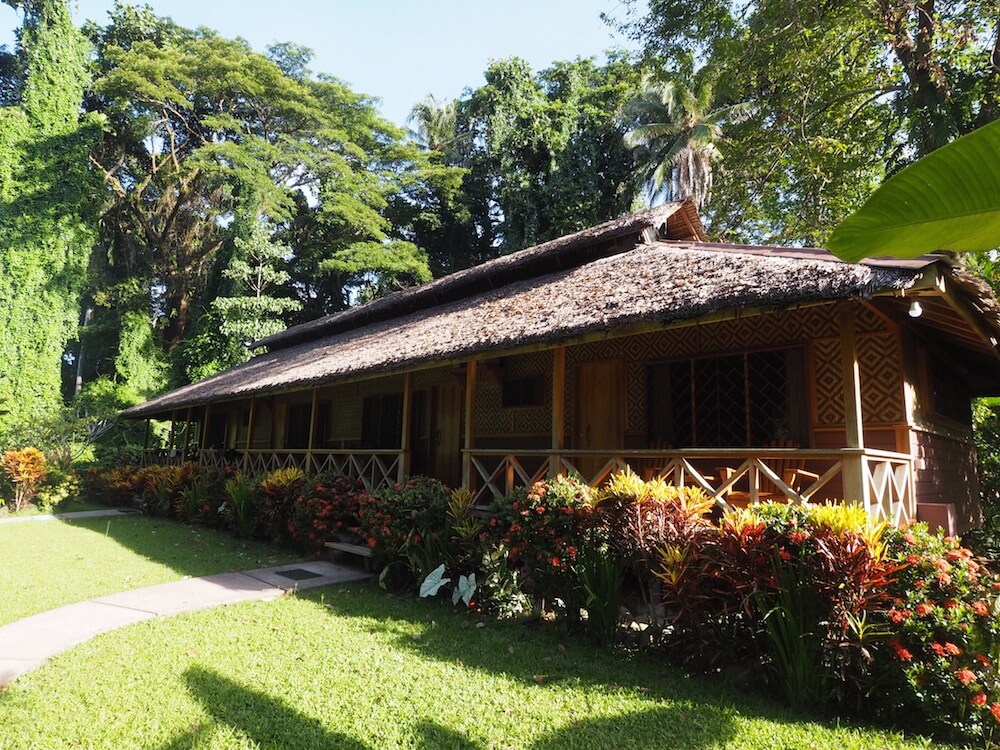
New Britain is definitely an area of Papua New Guinea rich in beauty and the Walindi Plantation Resort is well placed to enjoy it all.
Australians Max and Cecile have been running the resort for over 30 years. One of their staff members told me how everyone loved them round here because they brought in the tourists, so the money, and the jobs for locals. After all that time, and their legacy, their position in the community is cemented.
The scuba diving
The coral of New Britain in Papua New Guinea is a scuba diver’s dream. Every dive is a good one, so my lovely instructor from Walindi told me. I did two dives in a day and saw three sharks (one pregnant) and a tuna chasing mackerel, among many, many other fish, beautiful coral and sea life. Oh, I saw a seahorse too! That was exciting. And dolphins racing along with us in the boat.
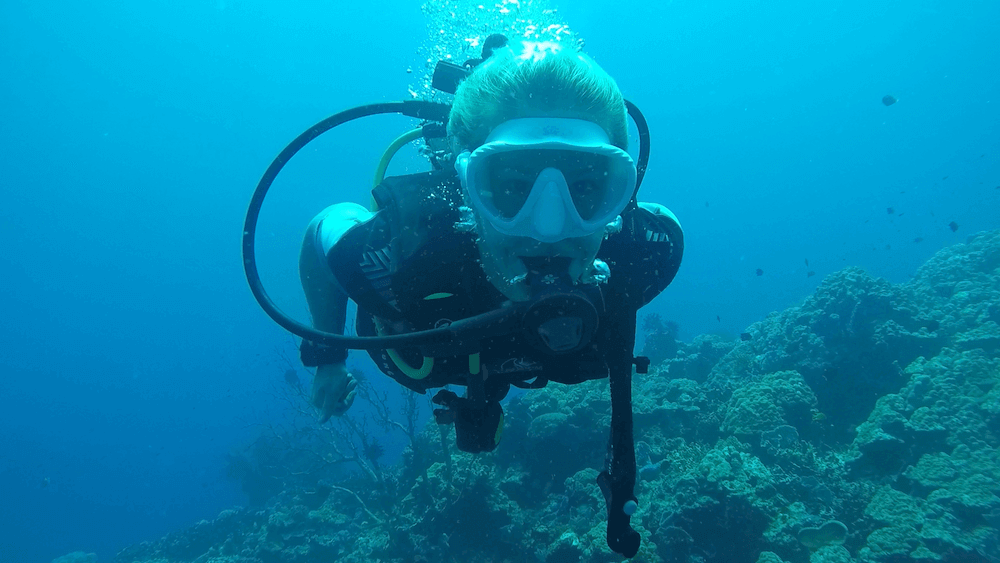
My day diving, and seeing the dolphins, was definitely my favourite day in Papua New Guinea. I can totally see why avid divers want to go all the way there to explore the waters.
Unfortunately there’s no way my Go Pro and skills could portray just how beautiful and colourful it was down there, so I’m afraid you’re going to have to colour it in with your imagination.
The other tourists
I didn’t really encounter many other tourists in Papua New Guinea. In the Highlands the only other tourists were retirees, mainly German or American.
At Walindi there was a good mix of nationalities, but again, all older – a Japanese couple, English, German again, but mostly Australians. There were two or three other younger people, but with their parents. Why aren’t more people travelling to Papua New Guinea?
Want to know more about Papua New Guinea? Read these PNG facts before you go.
The ‘danger’ of Papua New Guinea
Would be travellers usually cite ‘tribal wars’, ‘cannibalism’ and ‘expense’ as reasons not to visit Papua New Guinea.
I’ve just been looking up the cost of my trip, and yes, it was expensive, especially with the flight from the UK. You can get cheaper flights from Darwin though, so if you’re planning on visiting Australia for a long period of time, like so many people do, then you could add a trip to Papua New Guinea on for a relatively good price.
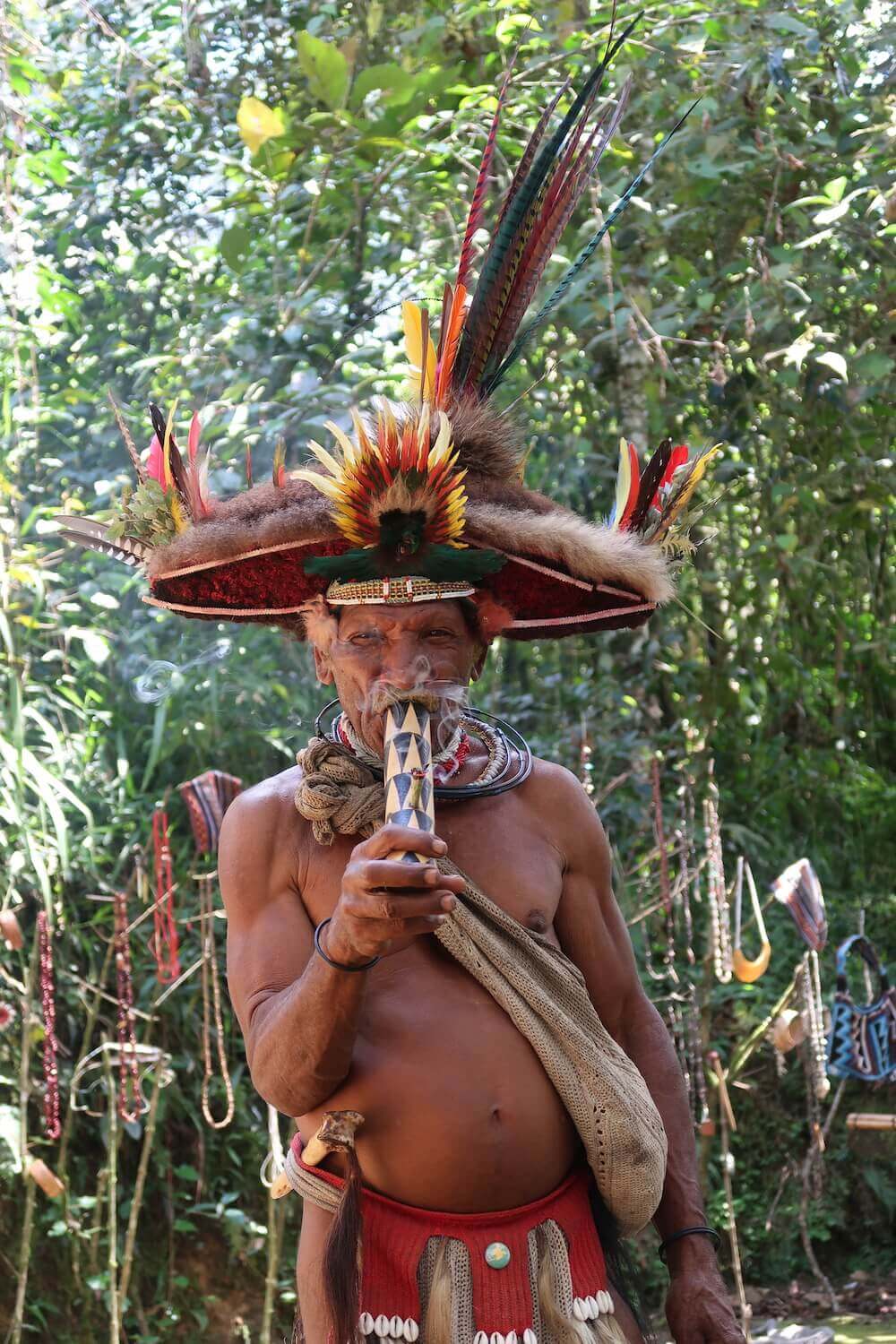
As for cannibalism, it was practiced in certain tribes in times gone by. You won’t get eaten in Papua New Guinea now – I bet you all the PNG Kina I can find. I mentioned it to a few guides, who dismissed it as stupid, but kind of funny, that people were staying away because of this belief.
With 800 different tribes living in Papua New Guinea, with all their own traditions and beliefs, there are going to be differences of opinion. So yes, tribal clashes are present. You need to know where to go in Papua New Guinea, and where’s safe. This can change often but if you stick to the usual tourist destinations, and use your common sense, you’ll be fine.
I didn’t feel in danger at any point in Papua New Guinea, although, I was there with PNG UK Tourism, which, of course, made me feel more secure. And when I was in the Highlands I was with Trans Niugini Tours (‘Papua New Guinea’s leading inbound tour operator’). Apart from the flights I was never alone.
I would travel independently in Papua New Guinea though, having seen it for myself, but I would get strong and trusted advice on the safe places to go at the time. I would also feel fine about doing any of the itinerary I did independently, but of course the security of a tour company should anything go wrong is always comforting.
Food in Papua New Guinea
I was expecting to do a ‘food of Papua New Guinea’ post, as I like doing so much (see ‘Food in Cuba‘ or ‘Food in Greece‘). But between bolognaise, meatballs, baked fish, breaded chicken, undercooked potatoes and salty veg, I don’t really have much to say. People don’t come to Papua New Guinea for the food.
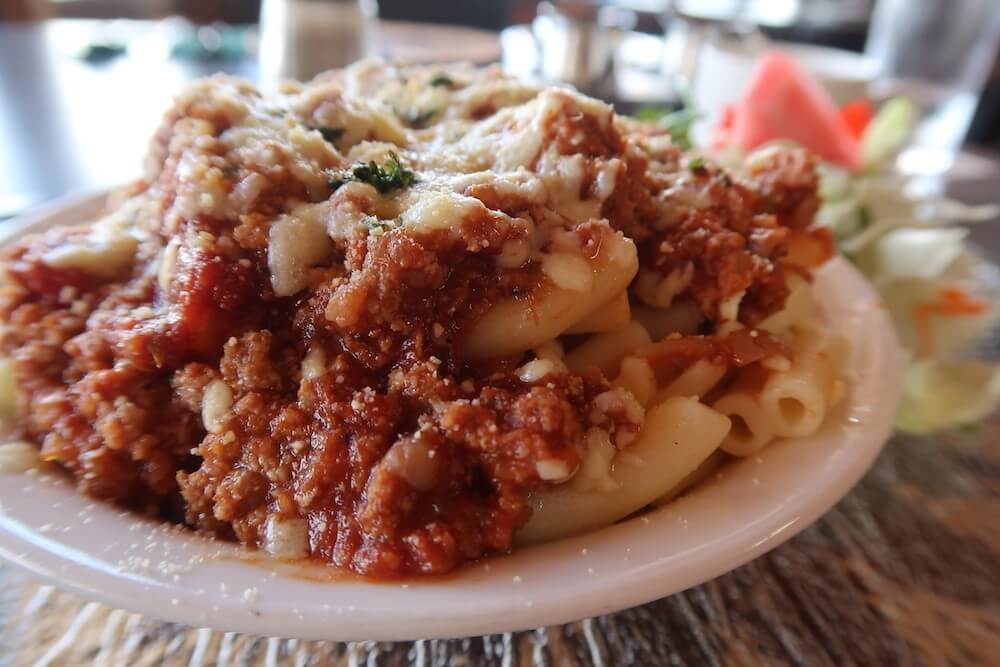
All my meals were eaten in the lodges where you get what you’re given, and I didn’t have the time or enough want to eat from the roadside shacks, as I normally would. I was ill by day two, at Rondon Ridge, and up all night. Everyone else seemed fine though, so I wouldn’t hold it against them – I seem to get ill in every country I go to now.
I did enjoy the bread at the lodges in Papua New Guinea. Every meal a delicious little hot bun accompanied the main, which I would slather in butter.
Breakfast was always eggs any way you like, with toast and jam, and there was also cornflakes, fruit platters and muffins.
I had packed lunches for the cultural tour days – a tuna sandwich, boiled egg and chocolate cake from Rondon Ridge, and then a quiche, cake and salad from Ambua Lodge.
The dinner buffet at Walindi was amazing – definitely the food highlight of the trip. With fresh fish, chicken and beef options every night, along with rice and the sweet potatoes I knew the Papua New Guineans loved so much. I really enjoyed the three dinners I had here, and that specially made Papua New Guinea ice cream we had every night was a taste sensation.
Lessons from Papua New Guinea
My trip to Papua New Guinea was a stark reminder of how different living in this world is for others. As I went round the villages I thought about what the residents would make of my friends’ houses in England, of the homewares, cooking appliances, space, unused junk.
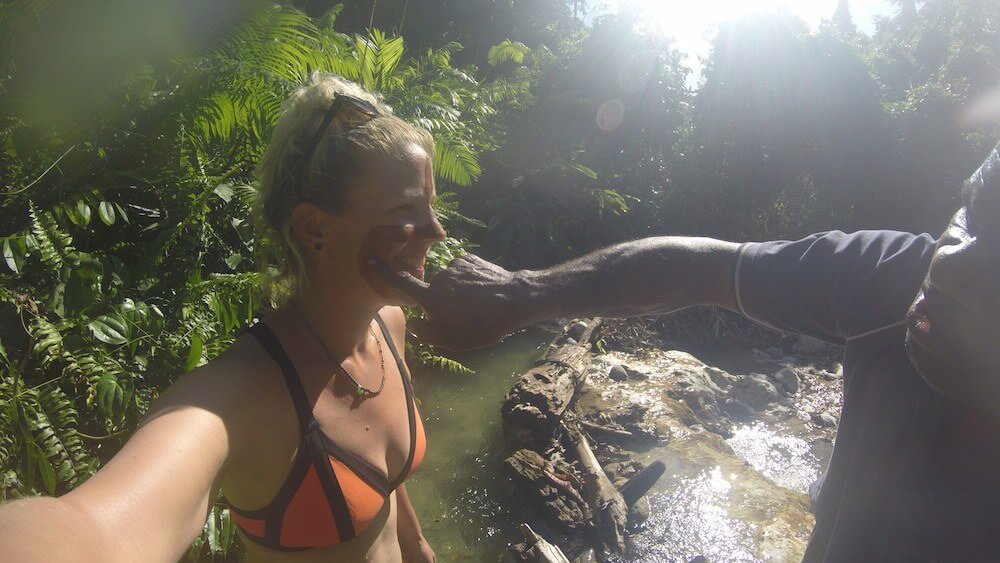
Last year someone said to me ‘every pound you spend is a vote for how you want your world to be’ and it’s stuck with me. With the over tourism in many countries now, and tourists flocking to the same places to get their selfies next to this tower, and that bridge, and by that lake, Papua New Guinea is somewhere where tourist money could really make a difference.
This is a country that needs more tourism to bring the money in and I think it’s absurd that more people aren’t visiting, when there’s so much to see and do.
Should you go to Papua New Guinea?
I would go again, once I’m over that flight out there. Next time I’d explore the Sepik – a long river that comes in from Indonesia and has a whole industry built up around it – and I’d stay at the Karawari Lodge, which just sounded incredible.
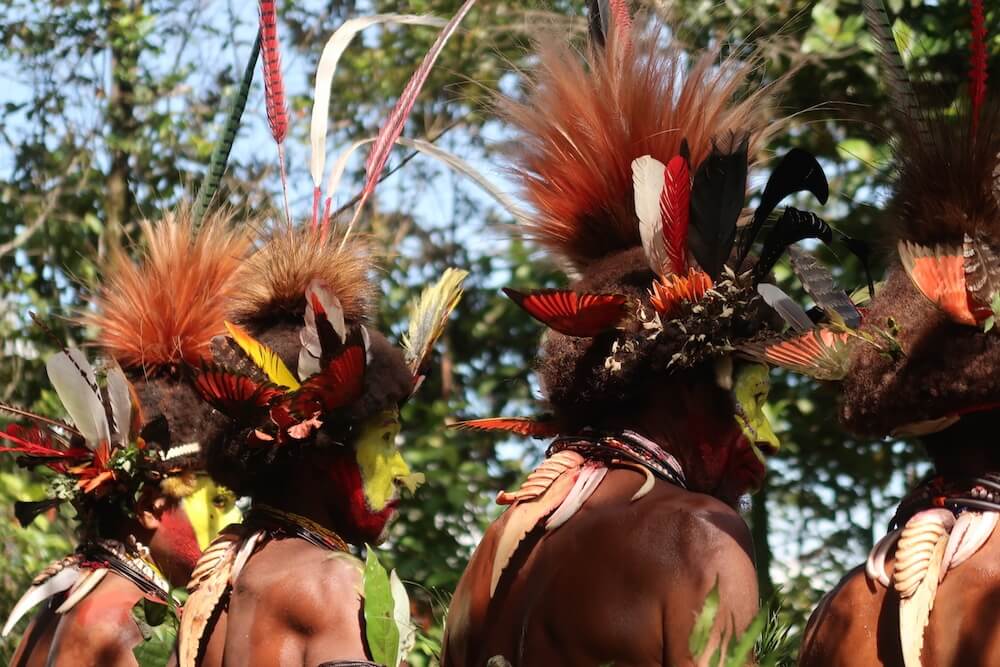
I’d also visit Tufi. A guy I met at Rondon Ridge Lodge, who’d travelled PNG extensively, told me Tufi was the best place to go if you wanted a quick insight into everything ‘Papua New Guinea’. He said it was like a microcosm of everything that was great about the country, from culture to diving to scenery and the birdwatching that many people visit for.
As the world gets more and more homogenised, Papua New Guinea is undoubtedly one of the most interesting and unique places I’ve ever visited. So yes, I’d totally recommend you go.
My trip to Papua New Guinea was sponsored by PNG UK. They invited me to come and explore the country in return for my thoughts on the blog – definitely lots of them to come!

Shocking the cannibals didn’t eat you
They’re actually trying to get rid of that stereotype. Very dated. Don’t think anyone’s been eaten for a very long time.
Hi Vicky. Thoroughly enjoyed reading your take on my country. I love my country and its people and yes, we are extremely friendly and hospitable. Having worked in the tourism industry for about 5 years now, I always find reviews of traveling to PNG interesting. Yours did us justice and so I want to thank you for that? A lot of people judge us from all the negativity portrayed by the media which I can tell you is absurd. Anyone reading this and planning on visiting PNG, take Vicky’s advice on using common sense when it comes to safety. And might I add, come with an empty cup willing to learn and appreciate a different and very unique way of life and cultures.
Hello Kezziah, I’m glad you think that I was fair on my views of the country. It was definitely an interesting place to visit and yes, I think it has a lot of unfair assumptions from people and the media. I hope to visit again one day!
This sounds like the most amazing place – hardly anywhere in the world really seems too remote or off the beaten track any more, but PNG is one that does. fantastic to actually see what it’s like there. Behind on my blog reading but can’t wait to catch up with your other posts!
Papua New Guinea definitely seems like one of the last places people have been to – and one of the most interesting. I feel like there’s very little known or read about it which is all part of the charm. From what I could see the only thing that could legitimately stop people going would be the price. I felt perfectly safe!
Ah! I have so many questions for you about your experience in Papua New Guinea! Will have to ask you all about them in person tomorrow! 🙂
Still got lots more to say about Papua New Guinea, and got a video or two on the way too. In short though, it’s definitely a cool place to see and I felt perfectly safe too. Go!
Great article. We just got back from a 9 night cruise to PNG and Solomon Islands.
One memory I’ll take back is the friendliness of the locals oh and the betel nut stained teeth! (Good call not trying it I think Vicky!)
Yeah, I can’t believe how much it stains people’s mouths and they just don’t care. No way I’m making my teeth go that red! Ah I’m glad you enjoyed it – the Solomon Islands must’ve been awesome! Another place I really want to see now!
I’m SO jealous of your trip to PNG! It sounds amazing, and it’s somewhere that’s always intrigued me. Really enjoyed following your adventures 🙂
Ah thanks Emily. It was a fascinating week. I’ve got lots I want to write about it, hopefully I’ll teach you a few things 🙂 Definitely recommend you visit one day!
Vicky, this sounds amazing! I can’t wait to hear more about your trip.
I’ve read so much about PNG through my degrees in Anthropology and have always been fascinated by the diversity of cultures there. I think you’re absolutely right, as the world becomes more globalised it’s easy to forget that we share this planet with people who live differently to us, and that’s something we should respect and acknowledge.
I’d love to visit the country one day, it’s totally on my list!
It was SO interesting. I have lots of blog posts I want to write :). You can expect lots more photos. That’s amazing you’ve read so much about it. At Walindi Lodge – one of the places I stayed – they had all the Phds that everyone had written based on PNG. There were a lot!
I hope you make it there one day – it’s such an interesting place to visit.